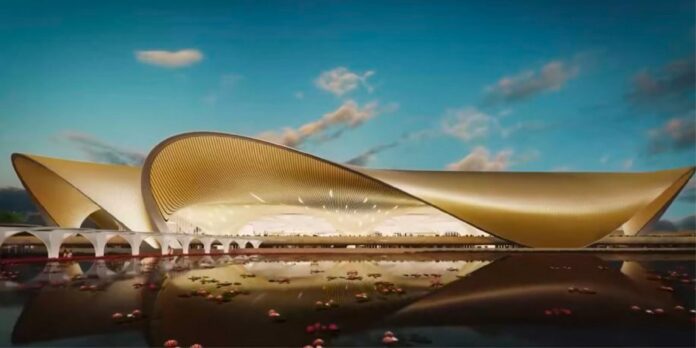Project Story: Connecting India’s Growing Metropolis
The Navi Mumbai International Airport (NMIA) has been conceived to address Mumbai’s rising air traffic and infrastructure pressures. With the existing Mumbai airport operating at near capacity, NMIA is designed to serve as a modern, efficient and future-ready gateway for India’s financial capital. Situated strategically in Navi Mumbai, the airport aims to ease congestion at the current facility, improve passenger and cargo connectivity, and stimulate economic growth across the region.
The ambition of the project is evident not only in its vast scale, spanning thousands of hectares, but also in its design philosophy, which marries sustainability, efficiency and cultural symbolism. The lotus-bud-shaped terminal, inspired by India’s national flower, reflects a careful balance between iconic architecture and practical engineering solutions.
BIM: The Blueprint of Precision and Structural Ingenuity
Building Information Modelling (BIM) formed the backbone of NMIA’s design and engineering process. It brought together architectural, structural and mechanical, electrical and plumbing systems into a single, data-rich 3D model. This integration allowed engineers to simulate complex steel frameworks, evaluate load distribution and identify potential conflicts before construction began, minimising errors and streamlining workflows.
The terminal’s lotus-bud shape presented unique structural challenges. Columns flare at the top to compensate for stiffness loss at the base, trusses are crafted from tubular steel to provide strength while reducing material usage, and the false ceilings are designed to be permeable, allowing natural ventilation. BIM enabled precise digital modelling of these features, simulating airflow, daylight penetration and energy performance across the entire terminal. By combining structural integrity with environmental efficiency, BIM ensured that the symbolic lotus design could be realised safely and effectively.
AI: Designing for Efficiency
Artificial Intelligence enhanced NMIA’s design through generative modelling, analysing large datasets to propose layouts that optimise passenger flow, security and operational efficiency. AI simulations guided the placement of concourses, trusses and circulation pathways, ensuring the terminal can accommodate future passenger volumes while maintaining comfort and safety. This data-driven approach allows the airport to anticipate operational challenges and adapt smoothly over time.
Digital Twins: Virtual Models for Real-World Impact
A key feature of NMIA is its Digital Twin, a real-time digital replica of the airport that mirrors both its physical and operational characteristics. By integrating BIM with Geographic Information Systems (GIS), the Digital Twin continuously monitors structural performance, predicts maintenance needs, and optimises resource allocation.
At NMIA, the Digital Twin is incorporated across multiple critical areas, including the terminal building, concourses, runway and taxiway systems, baggage handling networks, and mechanical and electrical infrastructure. For example, sensors embedded in steel trusses and columns feed live data into the system, allowing engineers to track structural stresses and detect any deviations from expected performance. Similarly, the ventilation and cooling systems are monitored in real time to optimise airflow and energy usage.
By simulating real-world conditions for both the structural and operational components, the Digital Twin enables proactive management, minimising downtime and improving efficiency. It also supports predictive maintenance, resource planning, and emergency simulations, ensuring the airport operates smoothly from day one while providing actionable insights for future expansions and operational improvements.
Architectural Innovation
Designed by Zaha Hadid Architects, the terminal’s lotus-bud form is both symbolic and functional. Its undulating roofline encourages passive cooling and maximises natural light, while the central atrium, designed to resemble a lotus pond, intuitively guides passengers through the space. Glass façades and patterned lattice screens mimic lotus leaves and reduce reliance on artificial lighting, further enhancing energy efficiency.
Structural Engineering
NMIA’s structural features bring the architectural vision to life. Tubular steel trusses provide strength with minimal material, and columns that flare at the top enhance stability. Permeable false ceilings allow for roof ventilation, improving air quality and lowering energy use. These innovations illustrate how steel and thoughtful engineering can create structures that are visually striking and environmentally responsible.
The Future of Airport Infrastructure
NMIA demonstrates how technology and design converge to shape next-generation airports. By harnessing BIM, AI and Digital Twin technologies, the airport is equipped to meet current needs while remaining adaptable to future challenges. The integration of digital tools ensures operational efficiency, cost-effectiveness and sustainability from design through construction and operation.
Setting the Standard for Future Airports
NMIA sets a global benchmark for airport development, demonstrating that digital technologies are essential for realising ambitious architectural visions. Lessons learned here—from optimising design and structural integrity to improving operational efficiency—will influence the next generation of infrastructure projects, where innovation, sustainability and efficiency are inseparable.
Expert Takeaway:
“Vibrational monitoring is being carried out to ensure the safety of the terminal and structural steel work, safeguarding both quality and long-term durability.” — Ramalingeswara Akasapu, Head of QA/QC, NMIA
The Navi Mumbai International Airport is slated for inauguration in October 2025, marking a significant milestone in India’s aviation and infrastructure landscape.
Stay tuned for next week, when we will explore more groundbreaking projects and innovations shaping India’s infrastructure landscape, offering insights and inspiration for architects, engineers, and industry professionals alike.




